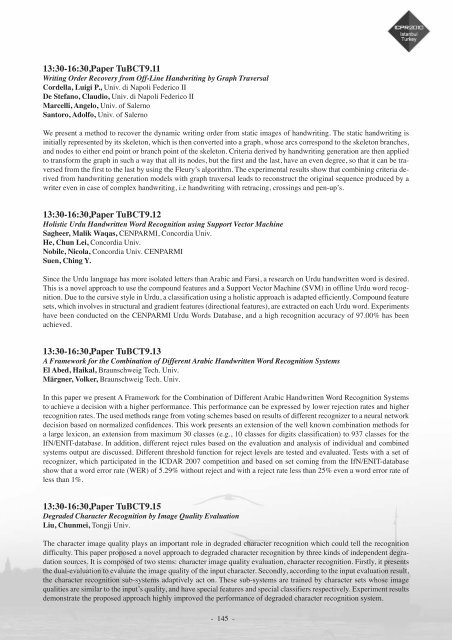Abstract book (pdf) - ICPR 2010
Abstract book (pdf) - ICPR 2010
Abstract book (pdf) - ICPR 2010
- TAGS
- abstract
- icpr
- icpr2010.org
Create successful ePaper yourself
Turn your PDF publications into a flip-book with our unique Google optimized e-Paper software.
13:30-16:30,Paper TuBCT9.11<br />
Writing Order Recovery from Off-Line Handwriting by Graph Traversal<br />
Cordella, Luigi P., Univ. di Napoli Federico II<br />
De Stefano, Claudio, Univ. di Napoli Federico II<br />
Marcelli, Angelo, Univ. of Salerno<br />
Santoro, Adolfo, Univ. of Salerno<br />
We present a method to recover the dynamic writing order from static images of handwriting. The static handwriting is<br />
initially represented by its skeleton, which is then converted into a graph, whose arcs correspond to the skeleton branches,<br />
and nodes to either end point or branch point of the skeleton. Criteria derived by handwriting generation are then applied<br />
to transform the graph in such a way that all its nodes, but the first and the last, have an even degree, so that it can be traversed<br />
from the first to the last by using the Fleury’s algorithm. The experimental results show that combining criteria derived<br />
from handwriting generation models with graph traversal leads to reconstruct the original sequence produced by a<br />
writer even in case of complex handwriting, i.e handwriting with retracing, crossings and pen-up’s.<br />
13:30-16:30,Paper TuBCT9.12<br />
Holistic Urdu Handwritten Word Recognition using Support Vector Machine<br />
Sagheer, Malik Waqas, CENPARMI, Concordia Univ.<br />
He, Chun Lei, Concordia Univ.<br />
Nobile, Nicola, Concordia Univ. CENPARMI<br />
Suen, Ching Y.<br />
Since the Urdu language has more isolated letters than Arabic and Farsi, a research on Urdu handwritten word is desired.<br />
This is a novel approach to use the compound features and a Support Vector Machine (SVM) in offline Urdu word recognition.<br />
Due to the cursive style in Urdu, a classification using a holistic approach is adapted efficiently. Compound feature<br />
sets, which involves in structural and gradient features (directional features), are extracted on each Urdu word. Experiments<br />
have been conducted on the CENPARMI Urdu Words Database, and a high recognition accuracy of 97.00% has been<br />
achieved.<br />
13:30-16:30,Paper TuBCT9.13<br />
A Framework for the Combination of Different Arabic Handwritten Word Recognition Systems<br />
El Abed, Haikal, Braunschweig Tech. Univ.<br />
Märgner, Volker, Braunschweig Tech. Univ.<br />
In this paper we present A Framework for the Combination of Different Arabic Handwritten Word Recognition Systems<br />
to achieve a decision with a higher performance. This performance can be expressed by lower rejection rates and higher<br />
recognition rates. The used methods range from voting schemes based on results of different recognizer to a neural network<br />
decision based on normalized confidences. This work presents an extension of the well known combination methods for<br />
a large lexicon, an extension from maximum 30 classes (e.g., 10 classes for digits classification) to 937 classes for the<br />
IfN/ENIT-database. In addition, different reject rules based on the evaluation and analysis of individual and combined<br />
systems output are discussed. Different threshold function for reject levels are tested and evaluated. Tests with a set of<br />
recognizer, which participated in the ICDAR 2007 competition and based on set coming from the IfN/ENIT-database<br />
show that a word error rate (WER) of 5.29% without reject and with a reject rate less than 25% even a word error rate of<br />
less than 1%.<br />
13:30-16:30,Paper TuBCT9.15<br />
Degraded Character Recognition by Image Quality Evaluation<br />
Liu, Chunmei, Tongji Univ.<br />
The character image quality plays an important role in degraded character recognition which could tell the recognition<br />
difficulty. This paper proposed a novel approach to degraded character recognition by three kinds of independent degradation<br />
sources. It is composed of two stems: character image quality evaluation, character recognition. Firstly, it presents<br />
the dual-evaluation to evaluate the image quality of the input character. Secondly, according to the input evaluation result,<br />
the character recognition sub-systems adaptively act on. These sub-systems are trained by character sets whose image<br />
qualities are similar to the input’s quality, and have special features and special classifiers respectively. Experiment results<br />
demonstrate the proposed approach highly improved the performance of degraded character recognition system.<br />
- 145 -



